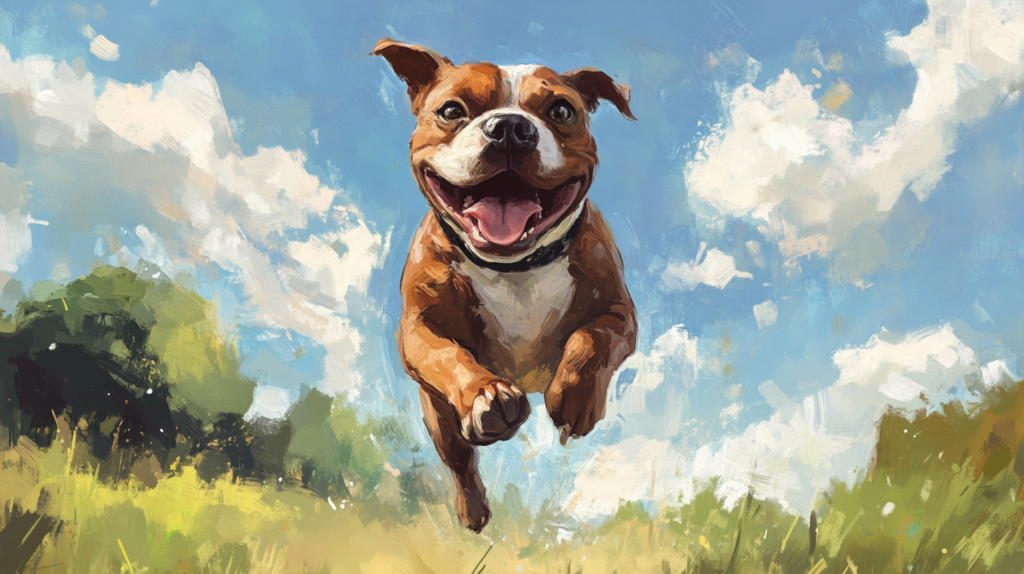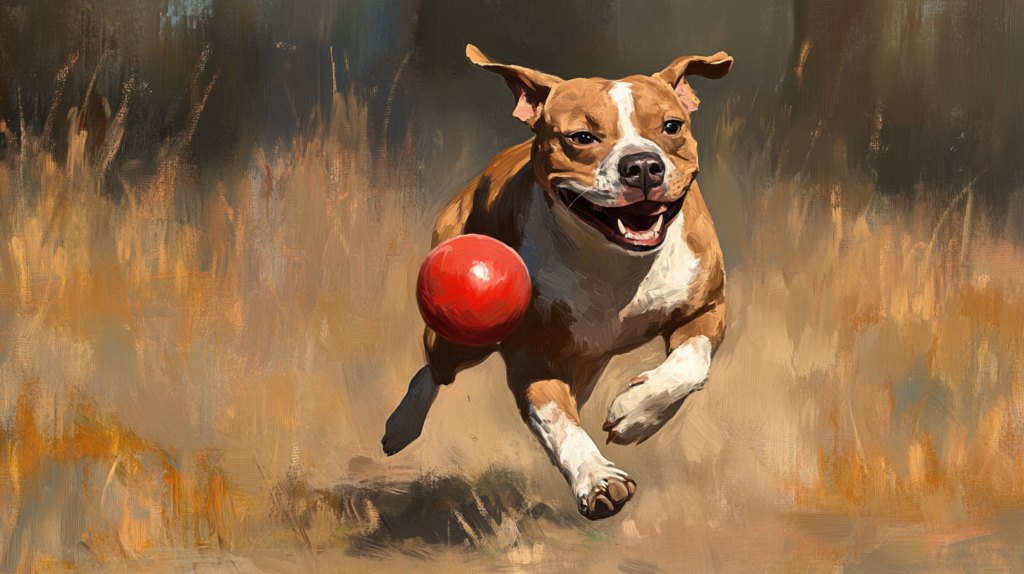Understanding AmStaff Health
In this article, we will explore the common health issues that can affect our beloved American Staffordshire Terriers (AmStaffs) and provide a helpful guide on how to prevent them. It is crucial for every AmStaff owner to be aware of these potential challenges in order to ensure their furry friend’s well-being.
What You Will Learn
Here are the key topics we will cover:
- Common health problems faced by AmStaffs, including hip and elbow dysplasia, skin allergies, and more
- Effective strategies for preventing these issues and keeping your AmStaff healthy and happy
- The significance of regular veterinary check-ups and maintaining a balanced diet
By being proactive about these health concerns, you can improve your American Staffordshire Terrier’s quality of life. Let’s get started on this journey toward better health for our four-legged companions!

Understanding the American Staffordshire Terrier Breed
The American Staffordshire Terrier (AmStaff) is a strong and loyal breed known for its muscular build, impressive strength, and loving nature. Here are some key traits:
Physical Characteristics
- Weight: Ranges from 40 to 70 pounds
- Height: Stands about 17 to 19 inches tall
- Coat: Short, requiring minimal grooming
AmStaffs are also known for their intelligence and playful behavior. They thrive on companionship and enjoy spending time with their families. Additionally, this breed has protective instincts, making them excellent family pets.
Historical Background
Originally bred in England for bull-baiting, the AmStaff has evolved significantly over time. The breed was recognized by the American Kennel Club (AKC) in 1936, reflecting its transition from a working dog to a beloved companion.
Understanding the breed’s history can help us identify potential health issues that may arise due to genetic factors. Common genetic diseases such as hip dysplasia and skin allergies are known to affect many AmStaffs. By being aware of these conditions, owners can provide better care tailored to their furry friends’ needs.

Common Health Problems in American Staffordshire Terriers
1. Hip Dysplasia
Hip dysplasia is a hereditary condition affecting many breeds, including the American Staffordshire Terrier (AmStaff). This malformation of the hip joint can lead to significant discomfort and mobility issues. Understanding its causes and symptoms is crucial for early detection and treatment.
What Causes Hip Dysplasia?
Hip dysplasia occurs when the hip joint doesn’t fit snugly into the hip socket. Factors contributing to this condition include:
- Genetics: A family history of hip dysplasia increases the likelihood of your AmStaff developing this issue.
- Rapid Growth: Puppies that grow too quickly may experience joint problems.
- Obesity: Excess weight places additional stress on joints, exacerbating the condition.
Symptoms to Watch For
Being vigilant about your AmStaff’s behavior can help catch hip dysplasia early. Key symptoms include:
- Difficulty getting up after resting
- Reluctance to participate in physical activities or play
- Limping or favoring one leg
- Decreased range of motion in the hind legs
If you notice these signs, a visit to the veterinarian is essential.
Diagnosis Methods
Veterinarians typically diagnose hip dysplasia through:
- Physical Examination: The vet will assess your dog’s movement and check for pain.
- X-rays: This imaging method allows for a clear view of the hip joints, confirming any abnormalities.
Early diagnosis is vital for effective management.
Treatment Options
Once diagnosed, several treatment options are available:
- Weight Management: Maintaining a healthy weight can alleviate pressure on the hips.
- Joint Supplements: Products containing glucosamine and chondroitin may support joint health.
- Medication: Anti-inflammatory medications can help manage pain and inflammation.
- Physical Therapy: Tailored exercises can improve strength and flexibility.
- Surgical Intervention: In severe cases, surgery may be necessary to correct the joint abnormality.
Regular health screenings for AmStaffs can help catch potential issues, such as hip dysplasia, before they become severe. Being informed about common health problems like this one empowers owners to take proactive steps in their dog’s care journey. Ensuring your AmStaff receives appropriate veterinary attention not only enhances their quality of life but also strengthens your bond with them.

Understanding these health concerns prepares you for what lies ahead as a responsible pet owner.
2. Elbow Dysplasia
Elbow dysplasia is a significant concern among American Staffordshire Terriers, classified as a hereditary condition that often leads to joint disease and even arthritis later in life. This condition emerges from abnormal development of the elbow joint, causing pain and discomfort for your furry friend.
Signs to Look For:
- Limping after exercise
- Difficulty with specific movements, such as climbing stairs or rising from a lying position
- Stiffness or reluctance to engage in playtime activities
Early detection plays a crucial role in managing this health issue. Veterinarians employ various diagnostic procedures to assess the severity of elbow dysplasia, including:
- Physical examinations: Assessing range of motion and pain levels
- X-rays: Imaging helps visualize bone structure and identify abnormalities
When elbow dysplasia is diagnosed, several treatment options may be recommended:
- Pain Management Strategies: Non-steroidal anti-inflammatory drugs (NSAIDs) can alleviate discomfort and improve mobility.
- Surgical Correction: In severe cases, surgical interventions may be necessary to repair or stabilize the joint.
- Weight Management: Maintaining a healthy weight through diet can reduce stress on the elbows.
Recognizing these signs and seeking timely veterinary care ensures better outcomes for AmStaffs facing this common health issue. Incorporating regular check-ups into your pet’s routine is essential for monitoring potential AmStaff health problems, including elbow dysplasia.

3. Progressive Retinal Atrophy (PRA)
Progressive Retinal Atrophy (PRA) is a hereditary condition that poses a significant risk to the vision of American Staffordshire Terriers. This genetic disorder affects the retina, leading to a gradual decline in eyesight. As the name suggests, it progresses over time, often resulting in total blindness.
Early Symptoms to Watch For:
- Night Blindness: Owners may notice their AmStaff struggling in low-light conditions or having difficulty navigating during evening walks.
- Dilated Pupils: An observable change in pupil size can indicate retinal issues and requires prompt attention.
Recognizing these signs early on is crucial for timely intervention. While there is no cure for PRA, there are several management techniques available to help affected dogs maintain a good quality of life.
Current Treatment Options Include:
- Environmental Adjustments: Modifying the living space can assist dogs with PRA in navigating their surroundings safely.
- Routine Veterinary Check-ups: Regular screenings can help monitor the progression of the disease and adjust care strategies accordingly.
- Supportive Care: Providing mental stimulation and engaging activities tailored to their capabilities helps keep AmStaffs active despite visual challenges.
Understanding Progressive Retinal Atrophy as one of the AmStaff common health issues enhances awareness among owners about their beloved pets’ needs. The more knowledge shared regarding American Staffordshire Terrier health problems, including PRA, leads to better proactive measures and health screening practices.

4. Hypothyroidism
Hypothyroidism in dogs, particularly in American Staffordshire Terriers, is a common health issue that occurs when the thyroid gland fails to produce enough hormones. This underactive thyroid can significantly impact various bodily functions, including metabolism and energy levels.
Common symptoms of AmStaff hypothyroidism include:
- Weight gain: Even with a normal diet, affected dogs may gain weight due to decreased metabolism.
- Excessive shedding: Owners might notice increased fur loss or changes in coat texture.
- Lethargy: Affected dogs often exhibit reduced energy levels and may seem less active than usual.
Diagnosis of hypothyroidism typically involves blood tests to measure hormone levels. Early detection is crucial for effective management of this condition.
For many owners, the journey doesn’t end with diagnosis. Management strategies recommended by veterinarians often include:
- Lifelong medication: Thyroid hormone replacement therapy is commonly prescribed to help regulate hormone levels and restore normal metabolic function.
- Regular monitoring: Regular veterinary check-ups and blood tests are essential to ensure the medication dosage remains effective.
Addressing AmStaff health problems like hypothyroidism promptly can lead to improved quality of life for our furry friends. When considering American Staffordshire Terrier health: common issues and prevention, awareness of such conditions plays a vital role in their overall well-being.

5. Cerebellar Ataxia
Cerebellar ataxia is a neurological disorder that significantly affects coordination and balance in dogs, including our beloved AmStaffs. This condition arises from the degeneration of the cerebellum, the part of the brain responsible for motor control.
Symptoms to Watch For
Signs of cerebellar ataxia typically begin to manifest between the ages of 3 to 6 years. As the disorder progresses, you might notice:
- Unsteady Gait: Dogs may stumble or appear wobbly while walking.
- Difficulty with Coordination: Challenges in performing routine activities like jumping or climbing stairs.
- Tremors: Involuntary shaking, especially noticeable in the limbs.
The progression of symptoms can vary among individual dogs. Some may experience a gradual decline in their motor skills, while others might show more sudden changes.
Diagnosis and Management
Veterinarians may use a combination of physical examinations and neurological assessments to diagnose cerebellar ataxia. While there is currently no cure for this hereditary condition, management strategies focus on enhancing your dog’s quality of life:
- Physical Therapy: Tailored exercises help improve strength and coordination.
- Safe Environment: Creating a space free from hazards ensures your dog can navigate safely.
- Regular Monitoring: Keeping an eye on any changes in behavior or mobility allows for timely veterinary intervention.
Understanding AmStaff common health issues like cerebellar ataxia is crucial. Regular health screening can identify concerns early, leading to better management options and improved overall well-being.
6. Skin Allergies
American Staffordshire Terriers are not just known for their loyalty and strength; they can also be prone to skin allergies. These allergies often lead to discomfort and can significantly affect their quality of life.
Types of Skin Allergies
Food Allergies: Certain ingredients in dog food, such as beef, chicken, or grains, may trigger an allergic response. For more information on food allergies in dogs, check out this resource.
Environmental Allergens:
- Pollen
- Dust mites
- Mold spores
- Fleas
Symptoms of Skin Allergies
Owners should keep an eye out for the following signs that may indicate an allergic reaction:
- Itching and Scratching: Constant scratching can lead to skin irritation and infections.
- Redness and Inflammation: Affected areas may appear red and swollen.
- Recurrent Ear Infections: Frequent ear infections can be a sign of underlying allergies.
Addressing these AmStaff common health issues early is crucial. Regular AmStaff health screening can help identify potential problems before they escalate. If you suspect your American Staffordshire Terrier is experiencing skin allergies, consulting with a veterinarian for proper diagnosis and treatment options is essential.
Identification of triggers often involves dietary changes or allergy testing. Treatment may include antihistamines, corticosteroids, or topical treatments to alleviate symptoms. For severe cases, a vet might recommend immunotherapy.
Understanding these American Staffordshire Terrier health problems ensures owners are prepared to provide the best care possible and maintain their furry friends’ comfort and well-being. It’s also important to note that some skin allergies could be related to seasonal changes, so being aware of common allergens can further assist in managing your pet’s health.

7. Other Common Health Issues
While American Staffordshire Terriers (AmStaffs) are generally healthy, they can be prone to a few less common but significant health problems. We have compiled a list of the most common health issues seen in this breed, along with their symptoms, causes, and potential treatment options.
1. Knee Ligament Tears
The cranial cruciate ligament tear can occur in active AmStaffs. Symptoms may include limping or reluctance to bear weight on the affected leg. Surgical intervention is often needed for effective recovery.
2. Dental Disease
Periodontal disease is common among AmStaffs due to plaque accumulation leading to gum infections and tooth loss. Regular dental check-ups and cleanings are crucial to maintain oral health.
3. Heart Disease
Though not as common as other issues, AmStaff heart disease can develop, leading to decreased stamina and lethargy. Regular health screenings can help detect these issues early.
Addressing AmStaff common health issues through proactive care ensures your furry friend remains healthy and happy!

Preventive Care Practices for American Staffordshire Terriers’ Well-Being
Nutrition and Diet for Optimal Health
A well-balanced diet is essential in ensuring the long-term health of your American Staffordshire Terrier. Here’s how to optimize their nutrition:
- High-Quality Protein: AmStaffs thrive on protein-rich diets. Look for dog foods that list meat as the primary ingredient. This helps maintain muscle mass and supports overall vitality.
- Essential Nutrients: Incorporate healthy fats, vitamins, and minerals into their meals. Omega-3 fatty acids can promote a shiny coat and healthy skin, while antioxidants help bolster the immune system.
- Controlled Portions: Obesity can exacerbate many health issues, including hip and elbow dysplasia. Measure food portions according to your dog’s weight, age, and activity level.
- Regular Feeding Schedule: Establish a consistent feeding routine. Two meals a day can help manage hunger and prevent unhealthy snacking.
- Hydration Matters: Fresh water should always be available. Proper hydration is crucial for digestion and overall health.
Exercise and Its Impact on Health
Regular physical activity is vital for maintaining an AmStaff’s physical condition and mental well-being. Here are some key points regarding exercise:
- Daily Exercise Requirement: Aim for at least 60 minutes of structured exercise daily. Activities like brisk walks, playtime in the yard, or agility training keep them engaged physically and mentally.
- Variety in Activities: Change up routines to prevent boredom. Incorporate fetch, tug-of-war, or swimming to make exercise fun while targeting different muscle groups.
- Socialization Opportunities: Group classes or dog parks provide social interaction with other dogs and humans. This exposure fosters good behavior and reduces anxiety.
Routine Veterinary Check-Ups
Preventive care extends beyond diet and exercise. Regular veterinary visits play a crucial role in early detection of potential health issues:
- Annual Wellness Exams: Schedule yearly check-ups to assess their overall health status. These visits are key for vaccinations, dental examinations, and screenings for common health issues.
- Early Detection Protocols: Discuss any changes in behavior or physical condition with your veterinarian promptly. Early diagnosis can lead to more effective treatment options.
By prioritizing nutrition, exercise, and regular vet visits, you pave the way for a healthier life for your American Staffordshire Terrier while minimizing the risk of common health problems associated with this beloved breed.
FAQs (Frequently Asked Questions)
What are the common health issues in American Staffordshire Terriers?
American Staffordshire Terriers are prone to several health problems, including hip dysplasia, elbow dysplasia, progressive retinal atrophy (PRA), hypothyroidism, cerebellar ataxia, and skin allergies. Each of these conditions has specific symptoms and treatment options that should be monitored by pet owners.
How can I prevent health issues in my American Staffordshire Terrier?
Preventive care is crucial for maintaining the health of American Staffordshire Terriers. This includes providing a balanced diet, ensuring regular exercise, scheduling routine veterinary check-ups, and being vigilant about any changes in behavior or physical condition that may indicate a health problem.
What are the signs of hip dysplasia in American Staffordshire Terriers?
Signs of hip dysplasia in AmStaffs include difficulty getting up, reluctance to engage in physical activities, limping, and decreased range of motion. If you notice these symptoms, it is important to consult a veterinarian for diagnosis and potential treatment options.
What is Progressive Retinal Atrophy (PRA) and how does it affect AmStaffs?
Progressive Retinal Atrophy (PRA) is a genetic condition that affects the vision of American Staffordshire Terriers over time. Early symptoms may include night blindness or dilated pupils. While there is no cure for PRA, management strategies can help maintain quality of life.
What dietary considerations should I keep in mind for my American Staffordshire Terrier?
A well-balanced diet tailored to the nutritional needs of American Staffordshire Terriers is essential for their overall health. Owners should consult with veterinarians to determine the best food options and feeding practices to support their dog’s specific health requirements.
Are there any other less common health issues I should be aware of for my AmStaff?
In addition to the more prevalent health issues like hip dysplasia and skin allergies, American Staffordshire Terriers can also experience knee ligament tears (cranial cruciate ligament tear) and dental diseases such as periodontal disease. Regular veterinary check-ups can help identify these issues early.







